Meta-analysis of clinical efficacy of Duhuo Jisheng Decoction in the treatment of lumbar intervertebral disc herniation
2020-06-06JunZhouLiuBoZhangZhenChengXiongHaoNingMaYanLeiWangYanSunMingShengTanPiYiFengYangXiangShengTang
Jun Zhou, Liu-Bo Zhang, Zhen-Cheng Xiong, Hao-Ning Ma, Yan-Lei Wang, Yan Sun, Ming-Sheng Tan✉, Pi Yi, Feng Yang, Xiang-Sheng Tang
1. Department of Spine Surgery, China-Japan Friendship Hospital, Beijing 100029, China 2. Graduate School, Beijing University of Chinese Medicine, Beijing 100029, China
3. Graduate School of Peking Union Medical College, Beijing, 100730, China
Keywords:
ABSTRACT
1. Introduction
Lumbar disc prolapse lumbar disc herniation(LDH) is due to intervertebral disc bulgin, nucleus pulposus prominent oppressed nerve root, spinal cord, or adjacent syndrome caused by blood vessels, with low back pain, one side or double lower limbs numbness, pain as the main clinical manifestations. Most of the patients are aged 20-50 years old, which has a serious negative impact on their daily life and normal work.[1]Lumbar disc herniation belongs to the category of "lumbago" and "arthralgia syndrome" in the traditional Chinese medicine theory. The unique living parasitic soup comes from "the preparation urgent thousand gold prescription", has the function of channeling meridian, invigorating liver and kidney, invigorating qi and blood, stopping pain. Now, evidence-based medicine is used to systematically evaluate and meta-analyze the relevant literature, and objectively evaluate the clinical efficacy and safety of duhuo parasitic decoction in the treatment of lumbar disc herniation. The report is as follows:
2. Materials and methods
2.1.Retrieve database
Computer retrieval of CNKI, VIP, Wan Fang Data, Pubmed, Cochrane Library, Medline complete and Embase databases.Chinese retrieval words include "Lumbar disc" and "bulging Lumbar" "slipped disk" Lumbar "shift" "back pain" "waist" LDH "and" "live with parasitic soup", the key words in English for the Intervertebral disc diseases, "or" Lumbar disc diseases, "and" Duhuo jisheng decoction ".The retrieval time is from the database establishment to July 20, 2019.
2.2.Inclusion and exclusion criteria
2.2.1.Inclusion criteria
Research object: the patient conforms to the diagnostic criteria of traditional Chinese medicine or western medicine for lumbar disc herniation. There is no limitation on gender, age and duration of the disease. (2) literature type: clinical randomized controlled trial (RCTS) study. Intervention measures: in the treatment group, there was no restriction on the dosage form and the way of administration. In the control group, there was no restriction on the routine treatment with western medicine.
2.2.2.Exclusion criteria
No clear grouping method; (2) clinical review, cases, research progress, animal experiments, etc. The control group is the literature of non-western medicine treatment, such as proprietary Chinese medicine.
2.3.Literature evaluation and data extraction
The subjects and abstracts were read by 2 researchers. According to the inclusion and exclusion criteria, the literatures that did not meet the inclusion criteria were excluded. Then the full text was read in detail and qualified literatures were selected.The two researchers independently extracted data, including title, first author name and year of publication, sample size, intervention measures and outcome indicators.The quality of the included literature was evaluated with reference to the Cochrane manual of systematic review by the Cochrane collaboration (version 5.1.0).Concealment and implementation bias of random scheme allocation;Blind method was used to detect the research objects and intervention implementers.Blind method of loss of follow-up bias was adopted for the result evaluators;Integrity of outcome indicator data;Selective reporting of research results;Other sources of bias.
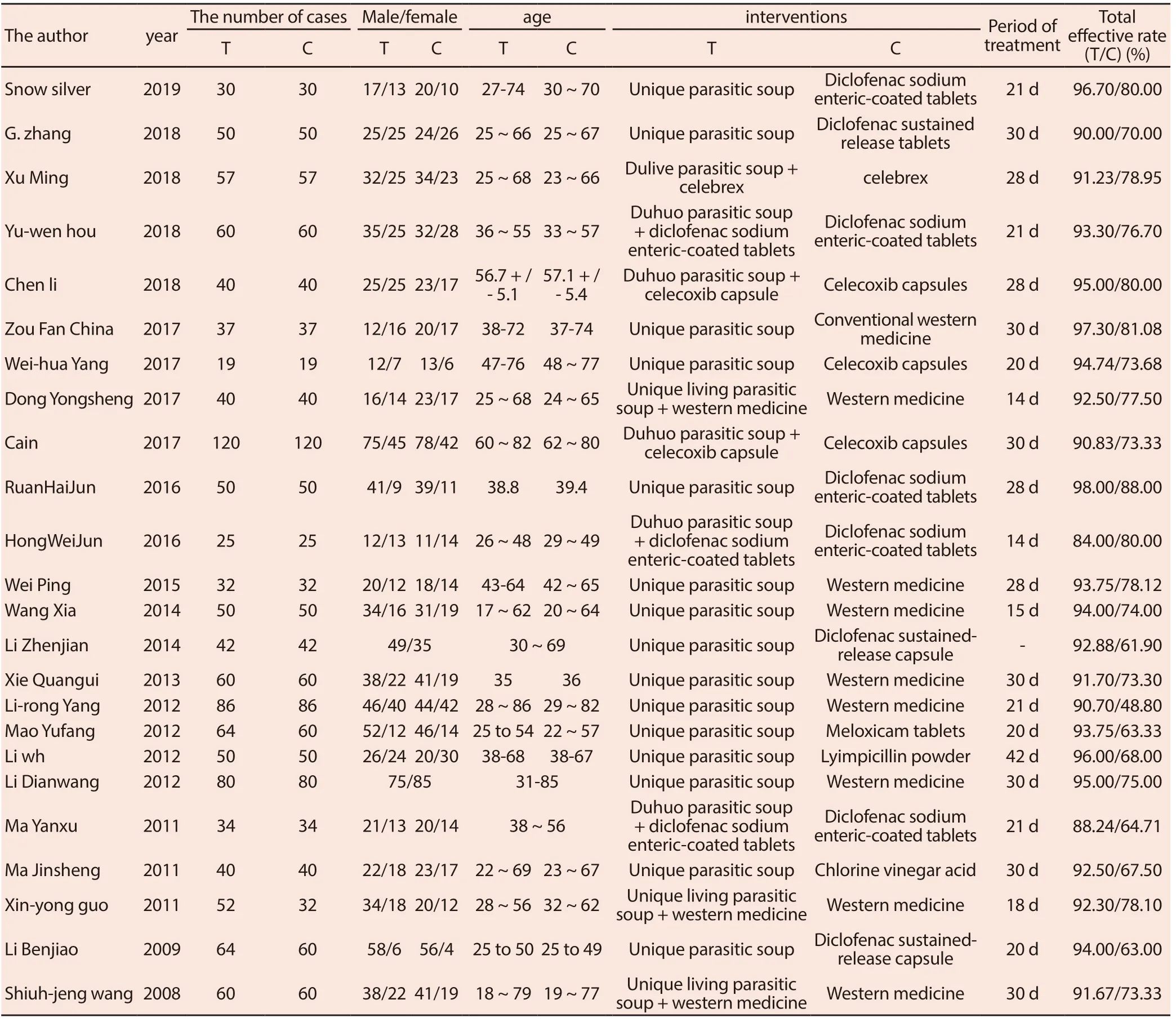
Table 1 Basic characteristics of the included literature
2.4.Statistical analysis of data
RevMan 5.3 was used for statistical analysis in Meta analysis. Ratio ratio (OR) was used as the eあect analysis statistic for dichotomous variables, and mean diあerence (MD) was used as the eあect indicator for continuous variables.The heterogeneity was tested by test and the heterogeneity was determined by I.22If I<50%, it is considered that there is homogeneity among multiple independent studies, and the fixed eあect model is adopted.2If I≥50%, the study is considered to have a large heterogeneity, and the random eあect model is adopted.2
3.Results
3.1.Literature screening results
Comprehensive retrieval by computer, CBM, CNKI, VIP, Wan Fang Data, Pubmed, the Cochrane Library, Medline complete and Embase database, a total of 1443 articles, among them 1439 references in Chinese, English 4 references, through careful reading literature summary and the full text, eliminate duplicate documents and do not meet the inclusion criteria of literature, eventually into Data analysis, a total of 24 references, the retrieval process is shown in figure 1, incorporated in the basic features of literature as shown in the table 1.[2-25]
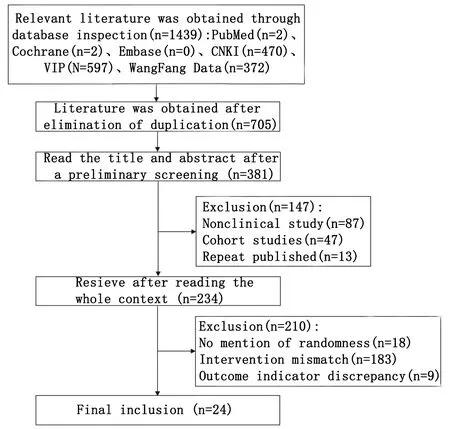
Figure 1 Experimental flowchart
3.2.Quality evaluation of the included literature
5 literatures specifically described the method of random allocation, 19 literatures only mentioned randomization but did not describe it, and 1 literature adopted double-blind, and none of the studies reported the results of subject shedding and selectivity, as shown in figure 2.[5,6,7,8,10] [2-25]
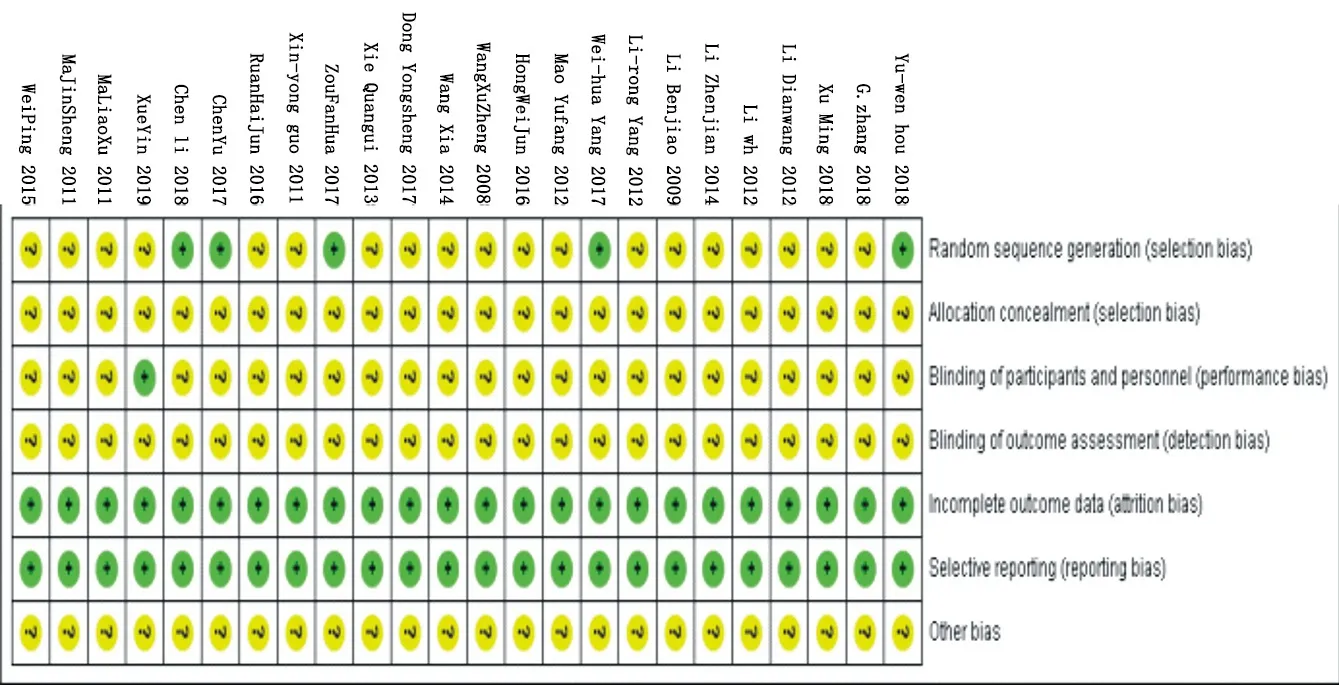
Figure 2 Bias risk assessment chart
3.3.Meta analysis results
3.3.1.The total clinical effective rate of the two groups after treatment
A total of 24 literatures reported the total eあective rate of duhuo parasitic decoction in the treatment of lumbar disc herniation, and there was no heterogeneity among the results (I=36%), so the fixed eあect model was used for Meta analysis.2The results showed that: OR=5.26, 95%ci (4.13, 6.69), Z=13.47, P < 0.00001, indicating that the addition of duhuo parasitic decoction OR combination of western medicine can significantly improve the total clinical eきciency of the treatment of lumbar disc herniation patients, and is better than the treatment of western medicine alone.(see figure 3 for details).According to whether combined western medicine, can be divided into living by parasitic tonga subtraction living by combined western medicine group and the parasitic decoction group and subgroup analysis, heterogeneity inspection with homogeneity between the two groups (I = 34%, I = 0%), so the fixed effects model, parasitic soup group alone OR = 7.59, 95% CI (5.47, 10.53), Z = 12.13, P < 0.00001, living by parasitic tonga subtraction combined western medicine group OR = 3.11, 95% CI (2.15, 4.51), Z = 6.01, P < 0.00001, both groups were statistically significant,The results indicated that the total eあective rate of treatment of lumbar disc herniation by combination of duhuo parasitic decoction and reduction of western medicine or reduction of duhuo parasitic decoction alone was higher than that of the western medicine group, as shown in figure 3.22
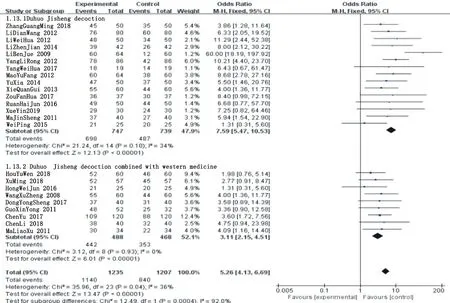
Figure 3 Comparison of total eあective rates between the two groups
3.3.2.Clinical recovery rate of the two groups after treatment
A total of 21 literatures mentioned the number of cured patients, and there was a high heterogeneity diあerence between the research groups (I=72%), so the random eあect model was used, OR=4.66, 95%ci (3.07, 7.18), Z=6.98, P < 0.00001. The results suggested that the addition OR reduction of duhuo parasitic decoction (OR) in the western medicine group was statistically significant in the number of cured patients compared with the conventional western medicine group.2According to whether combined western medicine, can be divided into living by parasitic tonga subtraction living by combined western medicine group and the parasitic decoction group and subgroup analysis, heterogeneity inspection have heterogeneity between the two groups (I = 73%, I = 67%), so a random eあects model, parasitic soup group alone OR = 5.92, 95% CI (3.36, 10.42), Z = 6.16, P < 0.00001, living by parasitic tonga subtraction combined western medicine group OR = 3.18, 95% CI (1.68, 6.01), Z = 3.57, P < 0.0004, both groups were statistically significant,It is suggested that the recovery rate of treatment of lumbar disc herniation by combination of dulive parasitic decoction and reduction of western medicine or combination of dulive parasitic decoction and reduction of treatment of lumbar disc herniation is higher than that of treatment of western medicine alone, as shown in figure 4.22
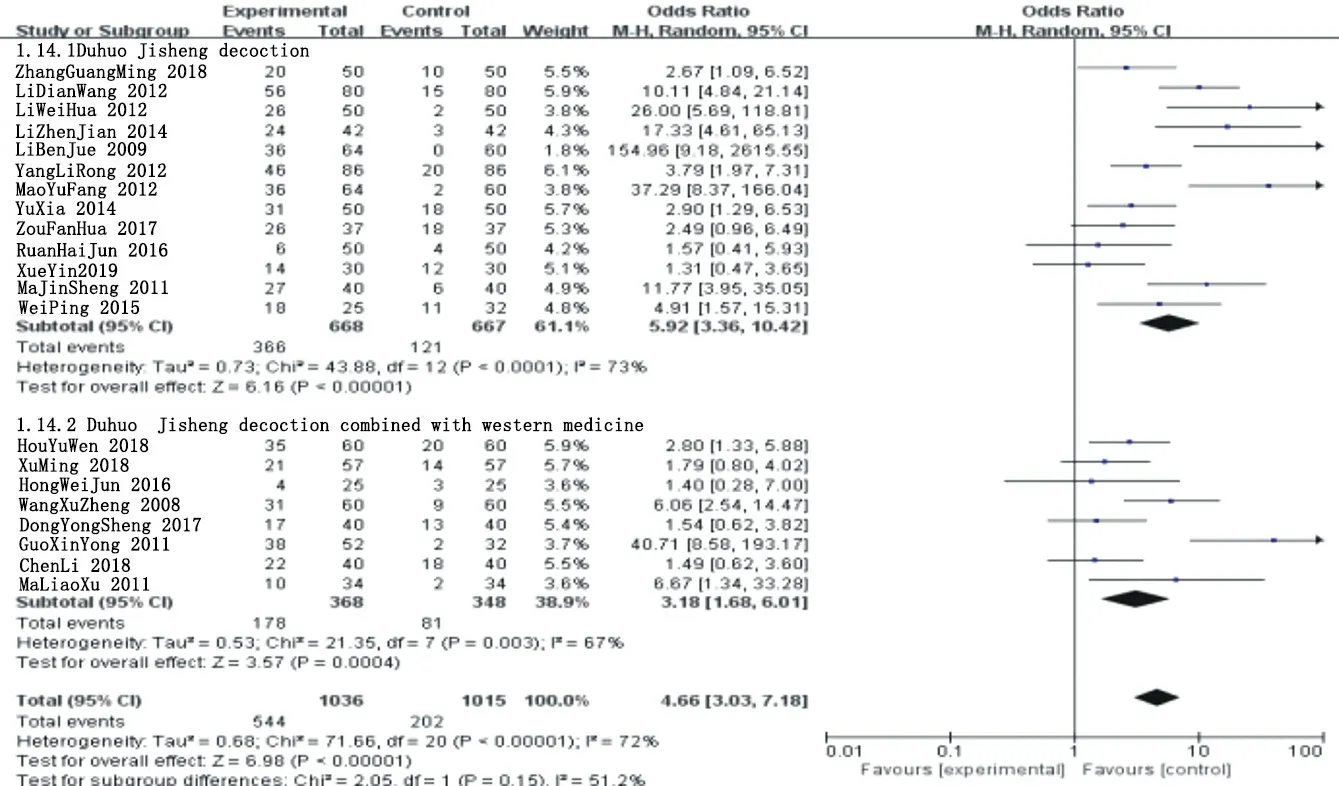
Figure 4 Comparison of healing rates between the two groups
3.3.3.Incidence of adverse reactions
In 24 articles were included, 6 articles were reported incidence of adverse reactions, no obvious heterogeneity among studies (I = 29%), so the fixed eあects model, 0 r = 0.45, 95% CI (0.23, 0.87), Z = 2.36, P = 0.02, living by parasitic tonga subtraction or combined incidence of adverse reaction less than western medicine group and western medicine diあerence is statistically significant, as shown in the figure 5.2

Figure 5 Comparison of adverse reactions between the two groups
3.3.4.VAS score
In 24 articles were included, 5 articles were using the VAS score as the ending index, high heterogeneity, diあerences between each team (I = 99%), so a random effects model, OR = 1.49, 95% CI (2.48, 0.49), Z = 2.93, P = 0.003, Meta analysis results showed that live with parasitic tonga subtraction union joint (OR not) to improve the VAS score is better than pure western medicine western medicine group, the difference is statistically significant, as shown in the figure 6.2

Figure 6 Comparison of VAS scores between the two groups
3.3.5.Clinical symptom score
In 24 articles were included, 2 paper used a clinical symptom scores as the ending index, no heterogeneity among the results of the study (I = 22%), so the fixed eあects model, Meta analysis OR = 2.13, 95% CI (2.29, 1.96), Z = 25.59, P < 0.00001, Meta analysis showed: live alone parasitic tonga subtraction union joint (OR not) are better than western medicine to improve clinical symptom scores of the western medicine group, the diあerence is statistically significant, as shown in the figure 7.2

Figure 7 Comparison of clinical symptom scores between the two groups
3.4.Sensitivity analysis
The results of meta-analysis were performed after the tests in each outcome index were eliminated one by one. The results showed that there was no statistically significant diあerence in the analysis results before and after the elimination, and the stability of this study was good.
3.5.Publication bias analysis
With the total eきciency as the index, a funnel plot was drawn to analyze the potential publication bias. The results are shown in Fig.8, indicating that the results are generally correct
Chen distribution indicated that the publication bias of included studies was not obvious.
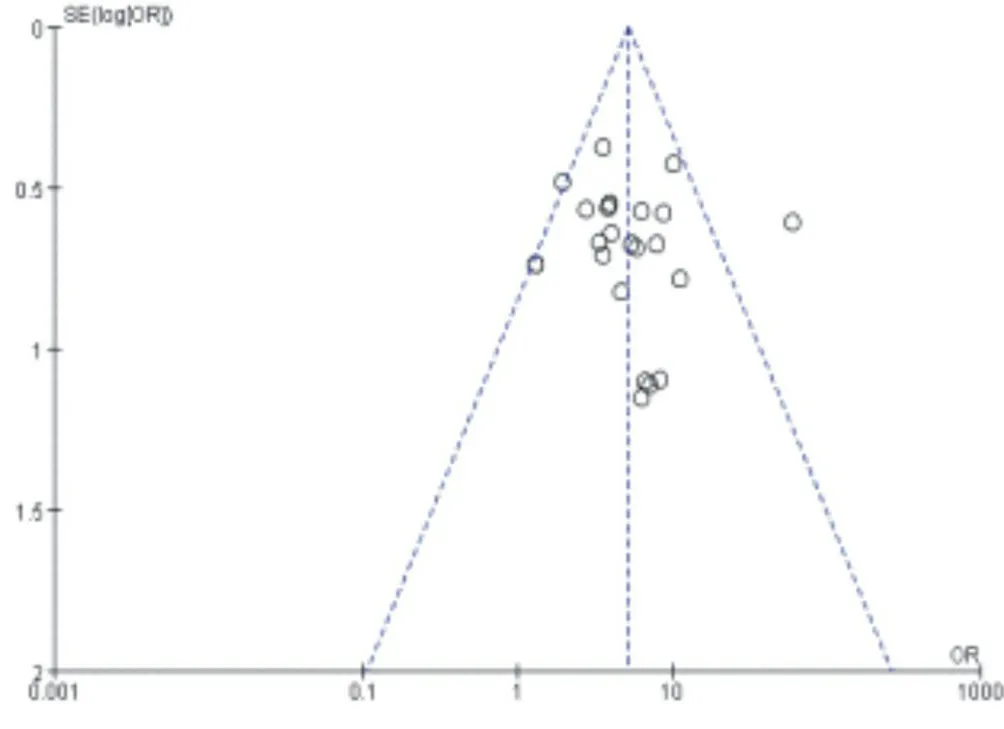
Figure 8 good diagra
4.Discussion
Lumbar disc herniation (LDH) is a common degenerative spinal disease in clinical practice. It is prevalent in patients aged 30-50 years old. About 95% of lumbar disc herniation occurs at L4/L5 and L5/S1 levels.Major symptoms of LDH include lower back pain, radiation pain in one or both lower limbs, reduced muscle strength, and sensory impairment.The development of LDH to severe stage can lead to muscle atrophy, dyskinesia and incontinence, which seriously affects the quality of patients' life and work.[26]The treatment methods of modern medicine for lumbar disc herniation include western medicine, interventional therapy and surgery, among which surgical treatment is the main method. Although conventional surgical treatment can achieve the purpose of decompression and release of nerve roots, the postoperative body trauma is large, recovery time is long, easy to form vertebral instability and other complications.[27]Traditional medicine has significant advantages in improving patients' clinical symptoms and relieving pain.
There is no disease name of "lumbar disc herniation" in the theory of traditional Chinese medicine. "Prepare urgent thousand gold to want square" say: "lumbar backache person, all is kidney gas is weak, lie cold wet when the wind get of".LDH is mainly due to the feeling of wind, cold, wet evil, falling down and injury, closed and blocked muscles and veins, resulting in abnormal qi and blood operation, not generally painful;Or because liver and kidney deficit is deficient, qi and blood are deficient, cannot normally soak in nourish waist muscles and bones, not rong is tong, so the treatment of LDH is more to enrich kidney to solidify, activate blood to remove stasis, warm Yang disperses cold and regulate qi to relieve pain as the basic treatment. Duhuo parasitic soup is originated from the preparation of qianjin prescription. It is mainly composed of duhuo, eucommia ulmoides, poria cocos, achyranthes bidentata, cinnamon, asarum, mulberry parasitism, ligusticum chuanxiong, angelica sinensis, gentiana gentiana, fangfeng, ginseng, peony, licorice and other drugs. In the prescription, the reuse of the unique function of dispelling wind and cold, dehumidification and analgesia, combined with mulberry parasitism, eucommia ulmoides, radix cyathulae can increase the eあect of dispelling wind, but also tonic liver and kidney. Ligusticum chuanxiong, radix paeoniae paeoniae, angelica nourishing blood and promoting blood circulation, ginseng, fuling invigorating spleen and invigorating qi, licorice mixed with various drugs, all drugs used in combination, playing the work of dispelling wind and dampness, tonifying liver and kidney, invigorating qi and blood, stopping bi pain. Modern pharmacological studies have shown that dushuo parasitic decoction inhibits the production of disc inflammatory factors and the degradation of extracellular matrix induced by sdf-1 through sdf-1 /CXCR4/NF-B pathway, suggesting that dushuo parasitic decoction can be used to treat lumbar disc herniation caused by disc degeneration.[28]
This study through the total eあective rate, cure rate and incidence of adverse reactions and clinical symptom scores, VAS score, living by using Meta analysis method of system evaluation parasitic soup treatment the curative effect and safety of LDH, suggests more parasitic tonga subtraction or combined western medicine treatment the curative eあect and safety of LDH is superior to conventional western medicine treatment, and can reduce pain and improve clinical symptoms. But it is undeniable that there still exists certain limitations of the study: 1) the 24 articles were included in the study, adopts the random grouping, but only 5 illustrates the specific method of random, the rest of the literature did not specify, only 1 article adopted double blind method, the rest of the document is not blind method, distribution of all documents not made hidden description; 2) the sample size of each clinical trial included in this study is small, so the evidence strength of literature conclusion is weak. In the future, high quality, large sample size and multi-center clinical studies are needed to verify, so as to provide high quality evidence for the clinical treatment of lumbar disc herniation.
杂志排行
Journal of Hainan Medical College的其它文章
- Effect of glycogen synthase kinase 3β on treatment of corticosteroneinduced depression in mice treated with Xiaobuxintang-2
- Explore the Mechanism of Ginseng on Breast Cancer Based on Network Pharmacology
- Based on data mining to explore the medication rule of Professor Shao Zheng-bin in the treatment of coronary heart disease combined with type2 diabetes mellitus after PCI
- Meta-analysis of the efficacy and safety of rhbnp in the treatment of acute myocardial infarction with heart failure
- Clinical efficacy of angina pectoris after pci in patients with coronary heart disease complicated with type 2 diabetes by Yiqi Yangyin and Huatan Tongluo recipe
- The effect of patients with chronic hepatitis B HBeAg(+)with poor response to treatment by converting to sequential treatment with tenofovir dipivoxil
